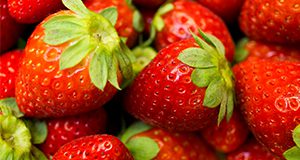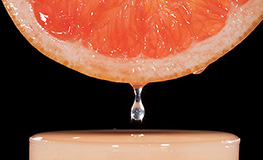Florida has the largest winter strawberry production in the United States. In recent years, Florida's industry has faced growing competition from Mexico. This 5-page fact sheet written by Feng Wu, Zhengfei Guan, and Melvin Garcia-Nazaraiega and published by the UF/IFAS Food and Resource Economics Department compares labor costs between Florida’s and Mexico’s strawberry industries.
http://edis.ifas.ufl.edu/fe1023
Tag: International Trade
Import Growth and the Impact on the Florida Strawberry Industry
The United States is the second largest producer of strawberries after China, and Florida, along with California, accounts for about 98% of the total US production. In recent years, the US strawberry industry has become increasingly concerned with competition from Mexico. This 3-page fact sheet written by Zhengfei Guan, Dong Hee Suy, Hayk Khachatryan, and Feng Wu and published by the UF/IFAS Food and Resource Economics Department describes the impact of imported strawberries on the Florida strawberry industry and explains how the industry can adapt to meet the challenge.
http://edis.ifas.ufl.edu/fe1022
An Overview of the Grapefruit Market in South Korea
According to the Foreign Agricultural Service of the United States Department of Agriculture, worldwide consumption of fresh grapefruit in 2014/15 increased from 4.2 million to 5.2 million metric tons. China, which is the largest producer of grapefruit, was largely responsible for the increase. In South Korea, however, the state of Florida in the United States has traditionally dominated the grapefruit market. The South Korean grapefruit market has been increasing in recent years and is expected to keep growing. The industry in Florida now faces fierce competition from other suppliers with lower import prices and different harvest seasons. This 5-page fact sheet written by Yan Heng, Hyeyoung Kim, and Lisa House and published by the Food and Resource Economics Department aims to provide an overview of the grapefruit market in South Korea and evaluate the potential of this market for Florida fresh grapefruit producers.
http://edis.ifas.ufl.edu/fe1003
US-Panama Free Trade Agreement: What Is in It for Florida Agriculture?
 On October 12, 2011, four years after it was agreed upon by both parties, the United States government signed into law the reciprocal US–Panama Free Trade Agreement (FTA)/Trade Promotion Agreement (TPA). The FTA provides US companies with better access to the Panamanian market and ensures that most US exports of consumer and industrial products to Panama will be accorded immediate duty-free privileges. The main elements of the US–Panama FTA as it relates to agricultural trade revolve around market access, agricultural export subsidies, safeguards, the sugar compensation mechanism, and sanitary and phytosanitary measures. This 11-page fact sheet was written by Edward A. Evans and Fredy H. Ballen, and published by the UF Department of Food and Resource Economics, May 2013.
On October 12, 2011, four years after it was agreed upon by both parties, the United States government signed into law the reciprocal US–Panama Free Trade Agreement (FTA)/Trade Promotion Agreement (TPA). The FTA provides US companies with better access to the Panamanian market and ensures that most US exports of consumer and industrial products to Panama will be accorded immediate duty-free privileges. The main elements of the US–Panama FTA as it relates to agricultural trade revolve around market access, agricultural export subsidies, safeguards, the sugar compensation mechanism, and sanitary and phytosanitary measures. This 11-page fact sheet was written by Edward A. Evans and Fredy H. Ballen, and published by the UF Department of Food and Resource Economics, May 2013.
http://edis.ifas.ufl.edu/fe932
US/Colombia Free Trade Agreement: What Is in It for Florida Agriculture? (FE905)
 On October 12, 2011, the US Congress ratified a Free Trade Agreement/Trade Promotion Agreement (FTA) with Colombia, five years after it was signed by President George W. Bush. The FTA took effect in May of 2012. This 13-page fact sheet highlights the key elements of the US Colombia FTA as they relate to trade in agricultural commodities, and to examine what is at stake for Florida. Written by Edward A. Evans and Fredy H. Ballen, and published by the UF Department of Food and Resource Economics, July 2012.
On October 12, 2011, the US Congress ratified a Free Trade Agreement/Trade Promotion Agreement (FTA) with Colombia, five years after it was signed by President George W. Bush. The FTA took effect in May of 2012. This 13-page fact sheet highlights the key elements of the US Colombia FTA as they relate to trade in agricultural commodities, and to examine what is at stake for Florida. Written by Edward A. Evans and Fredy H. Ballen, and published by the UF Department of Food and Resource Economics, July 2012.
http://edis.ifas.ufl.edu/fe905
European Food Safety Certification: The GlobalG.A.P® Standard and Its Accredited Certification Scheme (FSHN0801/FS145)
 Many European importers and retailers will only buy produce, meat, and grain-based products that come from GlobalG.A.P-certified farms. Despite its environmental origins, the main concern is food safety, followed by worker welfare, and then ecological matters. There are slightly different versions for fresh fruit and vegetables, meat products, flowers and ornamentals, and combinable crops (grains and pulses). There is also an Integrated Farm Assurance version for farms with several types of operations taking place at once. This 4-page fact sheet was written by Richard C. Yudin and Keith R. Schneider, and published by the UF Department of Food Science and Human Nutrition, February 2012.
Many European importers and retailers will only buy produce, meat, and grain-based products that come from GlobalG.A.P-certified farms. Despite its environmental origins, the main concern is food safety, followed by worker welfare, and then ecological matters. There are slightly different versions for fresh fruit and vegetables, meat products, flowers and ornamentals, and combinable crops (grains and pulses). There is also an Integrated Farm Assurance version for farms with several types of operations taking place at once. This 4-page fact sheet was written by Richard C. Yudin and Keith R. Schneider, and published by the UF Department of Food Science and Human Nutrition, February 2012.
http://edis.ifas.ufl.edu/fs145
Overview of US Agricultural Trade with China (FE902/FE902)
One bright spot in the US–China trade deficit is the trade of agricultural products, which continues to reflect a trade surplus that has grown considerably within the last decade. This 11-page fact sheet provides an overview of US–China trade of agricultural products, with special focus on produce, specifically over the period 2000 to 2010, and to highlight the main factors driving the widening of the agricultural trade surplus. The implications of modernizing the Chinese agricultural sector for the US fruit and vegetable industry are also discussed. Written by Xiuzhi Wang, Edward A. Evans, and Fredy H. Ballen, and published by the UF Department of Food and Resource Economics, February 2012.
http://edis.ifas.ufl.edu/fe902
The Role of the Codex Alimentarius in Determining International Standards for Pesticides and Food (PI237)
 People have the right to expect their food to be safe, of good quality, and suitable for consumption, and national governments must ensure that food imported from other countries is safe. But laws and regulations to minimize threats can create barriers to international food trade. The Codex Alimentarius aims to facilitate international trade by promoting definitions and requirements for foods. This 3-page fact sheet was written by F.M. Fishel, and published by the UF Department of Agronomy, August 2011. (image from usda.gov)
People have the right to expect their food to be safe, of good quality, and suitable for consumption, and national governments must ensure that food imported from other countries is safe. But laws and regulations to minimize threats can create barriers to international food trade. The Codex Alimentarius aims to facilitate international trade by promoting definitions and requirements for foods. This 3-page fact sheet was written by F.M. Fishel, and published by the UF Department of Agronomy, August 2011. (image from usda.gov)
http://edis.ifas.ufl.edu/pi237
FE803 Importación de Frutas Tropicales de Tailandia
FE803, an 8-page illustrated fact sheet by Edward A. Evans and Sikavas Nalampang, is the Spanish language version of FE719, Importation of Tropical Fruits from Thailand. It assesses the price competitiveness of imports of longan and lychee, outlines import regulations and highlights Thailand’s production and export trends for these commodities. Includes references. Published by the UF Department of Food and Resource Economics, July 2009.
http://edis.ifas.ufl.edu/FE803
FE730/FE730 Economic Analysis of the Australian Turfgrass Industry
FE730, a 24-page illustrated fact sheet by John J. Haydu, David E. Aldous, and Loretta N. Satterthwaite, reports the results of a 2006 survey of turfgrass producers in Australia, to provide industry benchmarks, determine financial costs and returns, and identify research priorities for the turfgrass industry. Includes references. Published by the UF Department of Food and Resource Economics, August 2008.
http://edis.ifas.ufl.edu/FE730
FE719/FE719 Importation of Tropical Fruits from Thailand
FE719, an 8-page fact sheet by Edward A. Evans and Sikavas Nalampang, assesses the price competitiveness of imports of longan and lychee, outlines import regulations and highlights Thailand’s production and export trends for these commodities. Includes references. Published by the UF Department of Food and Resource Economics, August 2008.
http://edis.ifas.ufl.edu/FE719
FE718/FE718 Recent Trends in World and U.S. Mango Production, Trade, and Consumption
FE718, a 7-page article by Edward A. Evans, summarizes some of the recent trends in world and U.S. mango production, trade, and consumption. Includes references. Published by the UF Department of Food and Resource Economics, August 2008.
http://edis.ifas.ufl.edu/FE718
FSHN 0801/FS145 European Food Safety Certification – The “GlobalGAP” Standard and its Accredited Certification Program
FSHN-08-01, a 5-page fact sheet by Richard C. Yudin and Keith R. Schneider, informs growers in Florida and elsewhere about this standard for agricultural products exported to the European Union, Switzerland, and Norway. Includes references. Published by the UF Department of Food Science and Human Nutrition, February 2008.
http://edis.ifas.ufl.edu/FS145

